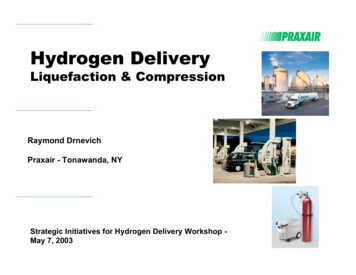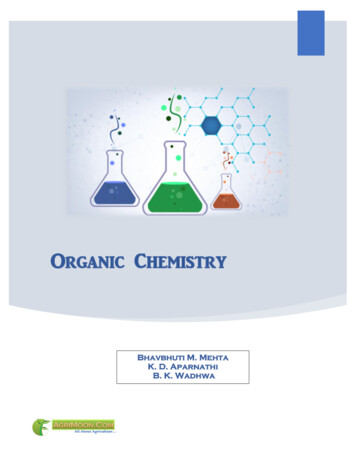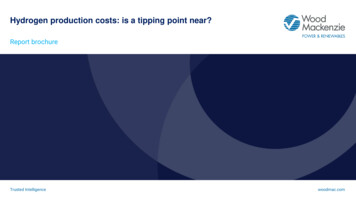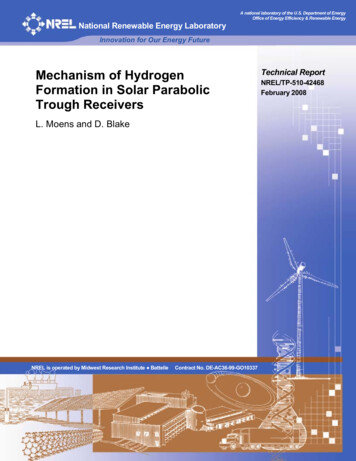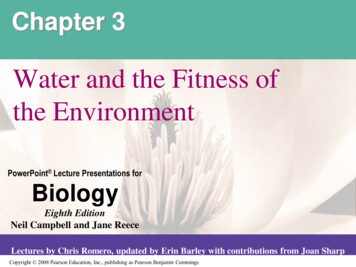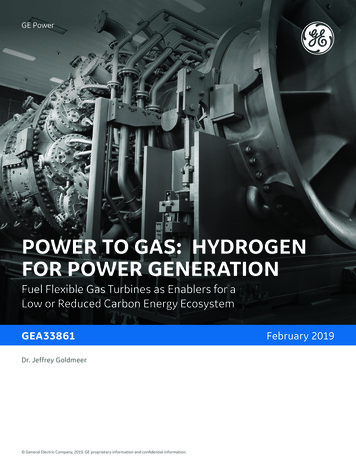
Transcription
GE PowerPOWER TO GAS: HYDROGENFOR POWER GENERATIONFuel Flexible Gas Turbines as Enablers for aLow or Reduced Carbon Energy EcosystemGEA33861Dr. Jeffrey Goldmeer General Electric Company, 2019. GE proprietary information and confidential information.February 2019
POWER TO GAS: HYDROGEN FOR POWER GENERATIONGEA33861ABSTRACTThe desire to reduce carbon emissions from traditional power generation assets is driving an increase in power production from renewables.However, an issue with large increases in renewable power generation is the lack of dispatchability; without adding storage or firmingcapability, increases in renewables can strain a power grid. Gas turbines can be used to fill this gap, but there are questions about the longterm use of these assets in a carbon-free energy ecosystem.An advantage for gas turbines is that they are able to operate on hydrogen(H2), which does not provide any carbon emissions whencombusted. This includes both new gas turbines and existing units which can be converted to operation on a high H2 fuel.This paper will provide an update on how gas turbines can support a low or reduced carbon electrical grid by operating on a wide variety oflower carbon fuels, including current hydrogen capabilities of GE gas turbines, requirements for upgrading existing turbines for operation onhydrogen fuels, and potential future technology options.INTRODUCTIONThe desire to reduce carbon emissions from power generation is creating a fundamental paradigm shift in the power generation industry.A direct result of this shift is an acceleration in the installed capacity of renewable power sources, including solar and wind. For example, 86% or 21 GW of the new power installations in Europe in 2016 were from renewable sources [1]. With the large and rapid increasesin installed capacity of renewable sources, there are concerns about the need to dispatch large blocks of power quickly to provide gridstability given the interruptible nature of some renewables. In these situations, the grid regulating agencies used dispatchable powergeneration assets (i.e. gas turbine power plants) to balance supply and demand.Although these assets are dispatchable and needed for grid regulation, there are questions being asked about utilization of these plantsin a potential future, carbon-free energy ecosystem. There are multiple approaches for low-carbon or carbon-free fuels, including the useof hydrogen for power generation [2]. Modern gas turbines are capable of operating on a wide range of H2 concentrations, with multiplecommercial power plants having considerable experience. Thus, gas turbines operating on hydrogen could provide the needed grid firmingwhile at the same time generating significantly less carbon dioxide (CO2) emissions.In an energy ecosystem that relies on H2 as a fuel for power generation, large volumes of H2 will have to be generated. There aretechnologies available today that can generate these large volumes of H2, including steam methane reforming and electrolysis of water; seeFigure 1. Steam methane reforming is the main production method for most of the hydrogen that is generated in the world today. But thisprocess generates CO2, so the use of carbon capture technologies would likely be required for this to be part of a carbon-free ecosystem.Steam Methane Reforming (SMR)WaterReformerNatural GasGas Turbine Power PlantsGas Turbine Power PlantsGas Engine Power PlantsGas Engine Power PlantsNatural Gas PipelineIndustrial CustomersRefineries andPetrochemical ApplicationsResidential Customers“Green Hydrogen”WindCO2H2Electrical PowerElectrolysisElectrical GridSolarFigure 1: Power to hydrogen energy ecosystem concept.2 General Electric Company, 2019. GE proprietary information and confidential information.
GEA33861POWER TO GAS: HYDROGEN FOR POWER GENERATIONElectrolysis of water is not a new concept. But using it to generate the volumes of hydrogen required for power generation will requirea large amount of energy, which could dramatically increase the cost of the hydrogen and the resulting power. An alternative solutionfor generating the large volumes might be to generate H2 from an electrolysis using renewable energy. This solution represents afundamental paradigm shift in the power generation industry; the rapid increase in installed capacity of renewable sources is creatingexcess power, leading to curtailment and in some situations creating a negative impact on electricity prices. Using curtailed power fromrenewable sources could potentially supply the power needed to generate what is being called “green H2”, hydrogen generated fromelectrolysis using renewable energy.This paper will examine the concept of producing and using hydrogen in gas turbines as an enabler for a reduced carbon (or carbon free)energy ecosystem.PRODUCTION OF HYDROGENHydrogen can be generated from a variety of feedstocks and chemical processes, as shown in Figure 2. These include (but are notlimited to) photosynthesis using algae, steam methane reforming (SMR) of natural gas, partial oxidation of crude oil, gasification of coal,and electrolysis of water. The next sections will provide details on steam methane reforming and electrolysis as potential pathways togenerating hydrogen for power generation.HYDROGENA clean, flexible energy carrier.Natural GasSolarWindGeothermalBiomassNuclearFossil FuelsElectricitySOURCES OF ENERGYHydrogen can be produced usingdiverse, domestic resources.PRODUCTION PATHWAYSElectrolysisBiologicalSteam MethaneDirect SolarReformingWater SplittingHydrogen can be produced usinga number of different processes.Figure 2: Pathways to hydrogen [3].Generating hydrogen: steam methane reformingToday, most of the hydrogen generated in the world comes from steam methane reforming. Much of this hydrogen is used in the productionof ammonia for fertilizers or in the production of petrochemicals. In this process, natural gas (methane) is reacted with water with a catalystand heat to generate H2 and CO2 via two reactions [4], [5]:CH4 H2O CO 3H2 (1)CO H2O CO2 H2 (2)Based on these equations, for each mole of methane used, one mole of CO2 and four moles of H2 are produced. Using the molecular weights listed inTable 1, for each kg of methane consumed, ½ kilogram of H2 and 2.75 kilograms of CO2 are produced. (For every kilogram of H2 produced, 5.5 kilogramsof CO2 are generated.) Putting this into perspective of the volumes required for power generation, a single 6B.03 gas turbine operating 8,000 hours peryear would consume approximately 33 million kg of H2 (per year). If the hydrogen was generated via SMR, this would produce 178,000 metric tonnes ofCO2 per year. Table 2 shows the rate of CO2 production when scaled to hydrogen production for some gas turbine platforms. General Electric Company, 2019. GE proprietary information and confidential information.3
POWER TO GAS: HYDROGEN FOR POWER GENERATIONGEA33861Table 1: Molecular weight of elements and molecules.FormulaMolecular thaneCH416WaterH2O18Carbon MonoxideCO28Carbon DioxideCO244Elements, MoleculesTable 2: Steam methane reforming requirements supporting 100% hydrogen operation.Output†MWHeat Input†GJ/hour(MMBTU/hour)100% H2Flow Ratekg/hourGE-1011.2129(122) 1,140 6,250 50,000TM250034.3350(332) 3,120 16,950 135,6006B.0344.0473(448) 4,170 22,900 183,0006F.0387857(813) 7,550 41,500 332,0007F.052432,197(2,083) 19,500 106,500 852,0009F.042882,677(2,537) 23,600 130,000 1,040,9009HA.025574,560(4,322) 40,200221,000 1,800,000Gas TurbineCO2 Generatedkg/hourMetric tonnes/year† ISO conditions operating on natural gasAlthough generating hydrogen via SMR creates carbon dioxide, there are a number of projects that are considering this pathway togenerating hydrogen by combining it with carbon capture and sequestration (CCS). Examples of projects considering generating hydrogenwith SMR are the H21 Leeds City Gate and the Magnum Vattenfall project. In the case of the City of Leeds project [6], it is estimated that2.4 billion m3 of hydrogen would be produced annually to provide heat and electricity to roughly 660,000 people. As part of this system,a 90% carbon capture system is being considered which will capture approximately 1.5 million tonnes of CO2 annually. The MagnumVattenfall project in the Netherlands has proposed to upgrade an existing gas turbine to operate on 100% hydrogen [7], [8]. The plan asproposed is to generate the hydrogen from natural gas, and the resulting CO2 will be captured and stored in underground bunkers.Open questions remain on transporting the hydrogen and storing the hydrogen at the power plant.The challenge of these projects is the goal of creating carbon-free power using a technology that requires large scale sequestration ofCO2. But, there are technologies that can generate H2 without generating CO2.Generating hydrogen: electrolysis of waterOne established method for generating hydrogen is electrolysis of water. Splitting water follows the following chemical reaction:H2O H2 ½ O2 (3)4 General Electric Company, 2019. GE proprietary information and confidential information.
GEA33861POWER TO GAS: HYDROGEN FOR POWER GENERATIONBased on this reaction for each mole of water used, 1 mole of hydrogen and one-half mole of oxygen are generated. Using the molecularweights listed in Table 1, each gram of water used will generate 0.11 grams of hydrogen and 0.89 grams of oxygen. (Notice that the totalmass is conserved.) In other words, generating 1 gram (1 kg) of hydrogen requires 9 grams (9 kg) of water, assuming no losses in theelectrolysis process. With this information, it is possible to compute the water required to support the power to hydrogen concept. Table 3shows the water required to generate enough hydrogen to operate different gas turbines on 100% hydrogen. For reference, an Olympic sizeswimming pool contains 2500 m3 of water; this means that an electrolyzer generating hydrogen for a GE-10 would use an equivalent volumeof water in approximately 250 hours (just over 10 days). Supplying hydrogen for a 9F.04 would use an Olympic pool of water every 12 hours.Operating a gas turbine on a hydrogen/natural gas blend instead of 100% hydrogen reduces not only the hydrogen flows, but the amountof water required to generate the hydrogen. For example, operating a 9F.04 gas turbine on a blend of 5% (by volume) hydrogen with naturalgas would require 3.2 m3/hour ( 840 gallons/hour) of water to generate the required hydrogen.Electrolysis also requires electrical power to split apart the water molecules. The amount of power required is defined by the higher heatingvalue (HHV) of hydrogen divided by the electrolyzer system efficiency [9]:“Electrolyzer Power” HHV/η (4)The HHV for hydrogen is 12,756.2 kJ/Nm3 (141,829.6 kJ/kg); this is equivalent to 3.54 kWh/Nm3 (39.39 kWh/kg). Assuming a 65% efficiencyelectrolyzer system, which represents commercially available technology, transforming water to hydrogen requires 5.45 kWh/m3 (60.61kWh/kg). Using the GE-10 gas turbine as an example, per Table 3 the hydrogen flow rate is 11,700 m3/ hour. To generate enough H2 tooperate the GE-10 for 24 hours, the electrolyzer system would consume 1.54 GWh of electricity. The electric power requirements formultiple turbines are shown in Table 3. Increasing the electrolyzer efficiency will reduce some of the power needs, as would operating thegas turbine on a blend of hydrogen and natural gas.Thus, large sources of power and water will be required to create a hydrogen ecosystem using electrolysis of water. The next sectionexamines the availability of renewable power to support this concept.Table 3: Electrolysis requirements supporting 100% hydrogen operation.Output†MWHeat Input†GJ/hour(MMBTU/hour)100% H2Flow Ratem3/hour(ft3/hour)Water Required toGenerate H2m3/hour(gallons/hour)Electrolysis PowerRequired††GWhGE-1011.2129(122) 11,700( 446,000) 10( 3,700) 500TM250034.3350(332) 31,800( 1,210,800) 27( 7,300) 1,5006B.0344.0473(448) 43,000( 1,635,900) 37( 9,900) 2,0006F.0387857(813) 78,000(2,970,000) 68( 17,950) 3,6007F.052432,197(2,083) 200,000( 7,600,000) 174( 46,000) 9,4009F.042882,677(2,537) 243,500( 9,266,900) 212( 56,000) 11,4009HA.025574,560(4,322) 415,000( 15,786,400) 361( 95,500) 19,500Gas Turbine† ISO conditions operating on natural gas†† Power required for electrolysis to supply H2 flow for gas turbine to operate on 100% H2 for 8000 hours General Electric Company, 2019. GE proprietary information and confidential information.5
POWER TO GAS: HYDROGEN FOR POWER GENERATIONGEA33861Renewable power for hydrogen generationTo support the concept of generating hydrogen with electrolysis using renewable power (also known as power to hydrogen), a largeamount of carbon-free power will be required. The good news is that the global drive for carbon-free power has led to an unprecedentedacceleration in power production from renewables; this is evident in statistics on power generated from renewable sources. As shownin figure 3, the electricity generated in Europe from renewables, including wind and solar, increased from 12.6 terawatt hours (TWh) in1990 to more than 570 TWh in 2016 [10].Not only was the total (or absolute) amount of power from renewable sources increasing, but the percentage of power from renewablesources relative to total power on the grid was also increasing. Table 4 shows the growth in renewables in multiple countries in Europebetween 2004 and 2016. It is interesting to note that many of the countries with the smallest increase in renewable penetration (i.e.Iceland, Sweden, and Norway) already had high rates of electricity generated from renewable sources in 2004. This growth in installedrenewable capacity continued in 2017. According to Wind Europe, an additional 6 GW of solar was installed, along with 15.6 GW of windpower capacity, in 2017. The installed wind power capacity in Europe is now estimated at 169 GW [11].A key to using renewable sources to generate hydrogen is having excess power, above and beyond that which is needed for electricaldemand. One way to gauge this capability is with curtailment of renewable sources. Table 5 shows wind curtailment for Germany, Ireland,Italy, and the UK between 2012 and 2016; data was not available for all countries in all years.600ELECTRICITY GENERATION FROMRENEWABLE SOURCES (TWH)500400300200100019901992199419961998Wood and Other Solid Biomass2000200220042006Biogas and Bioliquids20082010Wind Power201220142016Solar PowerFigure 3: Electricity generation from renewable sources in Europe (TWh) [10].Table 4: Increase in share of energy from renewable sources [10].2004 Share (%)2016 Share (%)Percent Growth inRenewables 2004-2016United 753.839%Norway58.169.419%Country6 General Electric Company, 2019. GE proprietary information and confidential information.
GEA33861POWER TO GAS: HYDROGEN FOR POWER GENERATIONTable 5: Curtailed wind power (GWh) 7434,722Ireland103171236Italy164106119United Kingdom453806591,277Given the significant growth in the use of renewable power sources, there is potential to use excess renewable energy to support a powerto hydrogen system. However, the power required for electrolysis of water to supply hydrogen for power generation (Table 3) for a F or HAclass gas turbine is larger than the curtailed renewable power shown in Table 5. Thus, creating an energy ecosystem that generates largevolumes of hydrogen for use in power generation will require much larger amounts of renewable power.GLOBAL INTEREST IN POWER-TO-GASThe global desire to reduce greenhouse gas emissions is a key driver for the interest in generating hydrogen for power. To that end thereare a number of groups examining potential technical and economic challenges of these concepts. Studies on the potential for powerto hydrogen have been published by multiple groups. One report, written by Trachtabel-Enge and Hinicio, articulated that “Power-toHydrogen is bankable already today” [12]. This same report also noted that stacking several revenue streams (i.e. refinery applications forH2, gas grid injection, etc.) can de-risk the business case and are “an effective way to achieve profitability”.Governmental support has ranged from white papers to international summits. A white paper published in mid-2018 by the HydrogenStrategy Group, which is chaired by the Chief Scientist of Australia, examined a vision in which the production of hydrogen supports(domestic) zero carbon electricity generation as well as the export of hydrogen [13]. The Japanese Ministry of Economy, Trade, and Industrypublished a basic hydrogen strategy document [14] that describes the importance of hydrogen in reducing the country’s greenhousegas emissions, as it could be a completely CO2 free energy source. Included in the document is the statement that Japan will “developcommercial-scale supply chains by around 2030 to procure 300,000 tons of hydrogen annually.”In late October 2018, the Japanese government sponsored a Hydrogen Energy Ministerial Meeting. The event was the first internationalministerial meeting “to hold discussion on the realization of a hydrogen-powered society as its main subject [15]. One of the outcomes of thismeeting was the signing of a Memorandum of Cooperation (MoC) between the Japanese Minister of Economy, Trade and Industry (METI) andthe New Zealand Minister of Business, Innovation and Employment (MBIE). The framework of the MoC is to “encourage the governments,industrial players and research institutes of both countries to collaborate, aiming to promote cooperation in the field of hydrogen” [16].In parallel there are companies developing and/or running small scale projects as a step towards understanding the technical and economicfeasibility of building and scaling up larger power to hydrogen systems. The US National Renewable Energy Lab is demonstrating thetechnical feasibility for power to hydrogen with an integration of wind turbines, photovoltaic arrays, and an electrolyzer system to generatehydrogen [19]. ITM Power has multiple small-scale installations in Europe that are already providing hydrogen for power from renewableenergy sources; in one case the hydrogen is injected into the local gas distribution network, and in the other it is stored and used withfuel cell to provide back-up power [20], [21]. In addition, the Australian Renewable Energy Agency (ARENA) is planning a trial of a newelectrolysis system in the city of Adelaide; the hydrogen generated from the electrolyzers will be injected into the cities gas distributionnetwork [22]. Long-term goals are to use renewables power for electrolysis to generate hydrogen for export [23]. General Electric Company, 2019. GE proprietary information and confidential information.7
POWER TO GAS: HYDROGEN FOR POWER GENERATIONGEA33861Power to hydrogen: fuel price forecasts and impact to cost of electricityThere are multiple studies evaluating the cost of hydrogen generated via electrolysis and renewable power. The table belowsummarizes some of the published price forecast.Report & Forecast PeriodForecast PeriodForecasted Cost Range ( /MMBTU)Hydrogen for Australia’s future [13]201830.4 – 46.82018 EIA World Energy Outlook [17]201835.2 – 52.8METI Basic Hydrogen Strategy [14]203027.2 (30 Yen/Nm3)METI Basic Hydrogen Strategy [14]Beyond 203018.2 (20 Yen/Nm3)Hydrogen for Australia’s future [13]205014.6 – 19.6As a reference, Henry Hub natural gas spot prices in the US are in in the range of 3-4/MMBTU, and estimated landed LNG pricestoday range from 9.39/MMBTU – 10.95/MMBTU in Europe, and 10.86/MMBTU in Asia [18]. ( are USD)Operating a power plant on a fuel whose cost ranges from 3x to 10x the current cost of natural gas will increase the cost ofelectricity (LCoE) by similar factors.CARBON EMISSION REDUCTION WITH HYDROGENHydrogen (H2) is a clean burning fuel that does not produce any carbon emissions as it does not include any carbon (C). In a complete andbalanced combustion reaction, which is the opposite of splitting water (Equation 3), hydrogen would produce only water:H2 ½ O2 H2O (5)Using 100% hydrogen as fuel for a gas turbine will lead to a significant reduction in carbon dioxide (CO2) emissions relative to operation onnatural gas or other hydrocarbon fuels. CO2 emissions attributed to the fuel will be zero, although the plant will still emit a very small amountof CO2 as there is approximately 0.04% (by volume) CO2 in the air that will be emitted with the products of combustion. For example, a gasturbine operating on 100% (by volume) H2 fuel will see a CO2 reduction of 99% relative to the CO2 emission on 100% methane.There are also cases where H2 blending with natural gas is being considered to reduce CO2 emissions as a near-term alternative tooperating on 100% natural gas. In these cases, the amount of CO2 reduction will be a function of the percentage of H2 in the fuel. Theamount or percent H2 in the fuel can be measured on a volume, mass, or heat input basis. There is a significant difference in the H2 flowsbased on these methods due to the difference between hydrogen’s energy density on a mass and volume basis as shown in Table 6.Table 6: Comparison of fuel lb21,51551,593FormulaMolecular WeightLHV (per volume)LHV (per mass)8 General Electric Company, 2019. GE proprietary information and confidential information.
GEA33861POWER TO GAS: HYDROGEN FOR POWER GENERATIONTypically, flows into a gas turbine are quoted on a volumetric basis, but the key factor in determining emissions for a fuel blend is the relativeheat input from the fuel constituents, especially as methane and hydrogen have very different energy densities. This is an important distinctionas adding small amounts of hydrogen to the fuel (on a volumetric basis) will have a smaller impact on carbon dioxide emission reduction. Figure 4shows the relationship between volumetric flow and heat input (mass flow) for a system using a blend of methane and hydrogen.1020% H2 (BY VOLUME FLOW)4050603070809010010010080806060CH4H2404020% H2 (BY HEAT INPUT)% CH4 (BY HEAT INPUT)02000100908070605040% CH4 (BY VOLUME FLOW)3020100Figure 4: Relationship between mass flow (heat input) and volumetric flow for a methane/hydrogen fuel mix.Using this information, the relationship between the amount of H2 in the fuel (by volume) and CO2 emission reduction can be defined; as shownin Figure 5 this relationship is clearly non-linear. The gas turbine requires a constant heat input and since H2 has a lower volumetric energydensity, a blend on a heat input basis contains less hydrogen (relative to a blend on a volumetric basis). As an example, a 9F.04 gas turbineoperating on methane at ISO conditions will emit 38.8 kg/sec ( 86 pounds/sec) of CO2. Switching this turbine to fuel that is a 5% / 95% (byvolume) blend of hydrogen and methane requires the same heat input, but due to the difference between mass and volumetric energy densityof hydrogen, this ends up as a 0.65% / 99.35% blend of hydrogen and methane on a heat input basis. This results in a CO2 emission of 38.2 kg/second ( 84.3 pounds/sec), which is roughly a reduction of 1.5% in CO2 emissions. Taking this one step further, to attain a 50% reduction in CO2emissions a blend that is 75% (by volume) hydrogen would be required.Instead, if the flows are set as a percentage of the turbine heat input, the relationship between H2 and CO2 reduction is linear as shown inFigure 6. To attain a 50% reduction in CO2 emissions requires a blend that is 50% hydrogen and 50% methane (by heat content).Understanding the magnitude of CO2 emission reduction relative to H2 content in the fuel is a key step in evaluating the value of a potentialpower to hydrogen system. However, one must also understand the technical challenges that accompany the use of hydrogen.0102030100908070HYDROGEN (VOLUME %)4050607080901003020100PERCENT REDUCTION IN CO2100806040200605040METHANE (VOLUME %)Figure 5: Relationship between CO2 emissions and hydrogen/methane fuel blends (volume %). General Electric Company, 2019. GE proprietary information and confidential information.9
POWER TO GAS: HYDROGEN FOR POWER GENERATIONGEA338610102030100908070HYDROGEN (% BY HEAT CONTENT)40506070809010020100PERCENT REDUCTION IN CO210080604020060504030METHANE (% BY HEAT CONTENT)Figure 6: Relationship between CO2 emissions and hydrogen/methane fuel blends (% heat input).THE CHALLENGES OF HYDROGENAlthough operating on hydrogen can lead to lower CO2 emissions, there are challenges that need to be understood given the differencesbetween hydrogen and many traditional hydrocarbon fuels. This section provides a summary of some key combustion issues.Heating valueThe lower heating value (LHV) of hydrogen (as was shown in Table 6) is 10.8 MJ/Nm3 (274.7 BTU/scf) or 120 MJ/kg (51,593 BTU/lb). In comparison,the LHV of 100% methane is 35.8 MJ/Nm3 (911.6 BTU/scf) or 50 MJ/kg (21,515 BTU/lb). On a mass basis, hydrogen is 2x more energy dense thatmethane. But, on a volume basis, hydrogen is one third less energy dense than methane. Therefore, it takes 3x more volume flow of hydrogen toprovide the same heat (energy) input as methane. Thus, operating a gas turbine on 100% hydrogen requires a fuel accessory system configuredfor the required flow rates.Flame speedIn a combustion reaction, the flame velocity or flame speed is the velocity at which the unburned gases propagate into the flame. The flamespeed of hydrogen is an order of magnitude faster than many hydrocarbon fuels. Table 7 lists the flame speeds for a set of common hydrocarbonfuels. From a gas turbine perspective, flame speed is an important property used in determining if a combustor may have issues with the flamepropagating upstream from the combustion zone into the premixing zone (near the fuel nozzles).Table 7: Laminar flame speed of common fuels [24].FormulaLaminar Flame Speed (cm/sec) atStoichiometric 6PropaneC 3H 842.3CO58.8FuelCarbon Monoxide10 General Electric Company, 2019. GE proprietary information and confidential information.
GEA33861POWER TO GAS: HYDROGEN FOR POWER GENERATIONTypically, combustion systems are configured to operate on a set of fuels that have a defined range of flame speeds. Due to the significant differencein the flame speeds of methane and hydrogen, combustion systems configured for operating on methane (or natural gas) may not be suitable foroperating on a high hydrogen fuel. In many cases, operating on a high hydrogen fuel requires a combustor specifically configured for the differentcombustion conditions. (See Combustion Technology section.)SafetyThere are additional operational challenges with hydrogen that relate to overall safety. First, a hydrogen flame has low luminosity and is thereforehard to see visually, as shown in Figure 7. This requires flame detection systems specifically configured for hydrogen flames. Secondly, hydrogencan diffuse through seals that might be considered airtight or impermeable to other gases. Therefore, traditional sealing systems used withnatural gas may need to be replaced with welded connections or other appropriate components. Thirdly, hydrogen is more flammable thanmethane; the lower flammability limit for methane (in air) is 5%, while for hydrogen it is 4% [25]. Therefore, hydrogen leaks could create increasedsafety risks requiring changes to plant procedures, safety / exclusions zones, etc. In addition, there may be other plant level safety issues thatmerit review [26].Figure 7: Comparison of natural gas and hydrogen flames.GAS TURBINE COMBUSTION TECHNOLOGYThe ability of gas turbine to operate on a high hydrogen fuel requires a combustion system that can deal with the specific nature of this fuel.Typical dry low NOx (DLN) combustion systems can handle some amount of hydrogen, but due the fundamental differences between hydrogenand methane previously discussed, these combustion systems are not able to handle moderate to high levels of hydrogen. Instead, combustionsystems that are configured to operate on fuels with higher concentrations of hydrogen are utilized. GE offers combustion systems for bothAeroderivative and Heavy-Duty gas turbines that are capable of operating with increased levels of H2, ranging from 5% (by volume) to 100% (byvolume). The various combustion systems capable of handling higher concentrations of H2 are shown in Figure 8.Aeroderivative Gas TurbinesSACHeavy-Duty Gas TurbinesSingle NozzleMNQCDLN 2.6eFigure 8: High hydrogen combustion systems. General Electric Company, 2019. GE proprietary information and confidential information.11
POWER TO GAS: HYDROGEN FOR POWER GENERATIONGEA33861Single annular combustorGE’s Aeroderivative gas turbines can be configured with a single annular combustor (SAC), which can operate on a variety of fuels, includingprocess fuels and fuel blends with hydrogen. There are over 2,600 gas turbines configured with this combustion system; these units haveaccumulated more than 100 million fired hours on a variety of fuels. Depending on the specific Aeroderivative gas turbine model, SACcombustors can handle hydrogen concentrations from 30% (by volume) up to 85% (by volume).1Single nozzle and multi nozzle combustorsGE’s Heavy-Duty gas turbines have two combustor configurations capable of operating on fuels with higher H2 content. The Single Nozzle(SN) or standard combustor is available on B and E-class turbines. The Multi-Nozzle Quiet Combustor (MNQC) is available for multiple E andF-class gas turbines. Combined these combustion systems have been installed on more than 1,700 gas turbines, and have accum
Figure 1. Steam methane reforming is the main production method for most of the hydrogen that is generated in the world today. But this process generates CO 2, so the use of carbon capture technologies would likely be required for this to be part of a carbon-free ecosystem. Figure 1: Power to hydrogen energy ecosystem concept.
